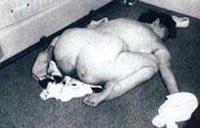The Pro-Abortion Movement
It is worth noting that the pro-abortion movement also achieved social reform, in part, through the use of graphic depictions of what they were fighting against. One doesn’t have to agree with their conclusion in order to agree that their methodology worked. Canadian abortionist Garson Romalis conveys the power of graphics in his 2008 National Post article, “Why I am an abortion doctor.” He wrote, “Abortion was illegal when I trained, so I did not learn how to do abortions in my residency, although I had more than my share of experience looking after illegal abortion complications.”1 Indeed, he did. He began his obstetrics and gynecology residency in 1962 and “will never forget the 17-year-old girl lying on a stretcher with 6 feet of small bowel protruding from her vagina.”2

The graphic image Romalis saw in-person was something abortion advocates knew would help sway public opinion, and policy, in their favour. In 1964, an American woman, Gerri Twerdy Santoro, was found dead as a result of a self-induced illegal abortion. She was only 28 years old and had two other children. Fearing her abusive estranged husband would kill her if he discovered she was pregnant by another man, she and her boyfriend aborted their pre-born child. In the process, she herself died and was found lying face down in a pool of blood. The photograph of this horrific site first appeared in MS Magazine in April 1973.3 It has since been used by the pro-abortion movement as a tool to make their case for why abortion should remain legal.
The tactic of conveying the devastation of illegal abortion was also used by Canadian abortion-rights. In April 1970, a group of Vancouver activists set out to Ottawa. Their numbers swelled (from over a dozen to hundreds) as the trip’s participants drew close to their destination. When the Minister of Justice refused to attend a scheduled meeting with the activists, they protested at Prime Minister Trudeau’s residence. They wanted to draw attention to the deaths of women who perished from illegal abortion so they displayed a coffin on Trudeau’s lawn, piling objects in it that women used to perform illegal abortions, such as knitting needles, a Lysol container, and a vacuum cleaner hose.4
Back to Historical Social Reform
- Garson Romalis, “Why I am an abortion doctor,” The National Post, February 4, 2008.
- Ibid.
- “Gerry Twerdy Santoro,” lifeandlibertyforwomen.org/gerri_twerdy_santoro.html.
- Joyce Arthur, “Winning Choice on Abortion: A Book Review,” Pro-Choice Press, Spring 2005, www.prochoiceactionnetwork-canada.org/prochoicepress/05spring.shtml.
